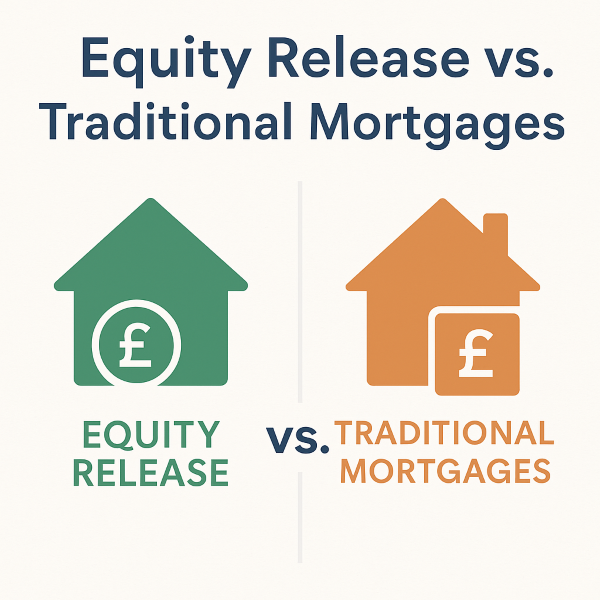A flexible lifetime mortgage (FLTM) is a type of equity release product available to UK homeowners aged 55 or older. It allows individuals to access tax-free cash, either as a lump sum or through smaller payments, by borrowing against their home. This product is designed to provide financial support without requiring the sale of your property.
Flexible Repayment Options
The “flexible” aspect of an FLTM refers to the repayment options it offers. Borrowers can choose to make monthly interest payments to manage the overall balance. Alternatively, they may roll the interest into the loan, which increases the total amount owed over time. While adding unpaid interest can significantly raise the debt, regular payments help maintain equity in the property.
Key Considerations Before Choosing
When considering an FLTM, it’s essential to weigh the costs, risks, and benefits carefully. Adding interest to the loan accelerates the total owed, which may affect future inheritance plans. Seeking independent financial advice is highly recommended to understand the implications fully. Comparing products from different providers can also help you find a solution that fits your long-term goals.
By understanding the options and seeking expert guidance, homeowners can make informed decisions that align with their needs and priorities.
How Does a Flexible Lifetime Mortgage Work?
A flexible lifetime mortgage (FLTM) operates similarly to other lifetime mortgages, but it offers greater adaptability.
To start, you’ll consult a financial adviser who can guide you through the application process. Since FLTMs are advised products, professional advice is mandatory. The interest rate you receive will depend on the flexible lifetime mortgage rates available at the time of application.
The application process typically takes four to six weeks. Our article, How Long Does Equity Release Take?, provides a detailed process overview. Below are some key points to consider as you set up and begin using your FLTM:
- Interest Payments and Compounding
If you choose to add interest payments to your loan, the total owed can increase rapidly. This happens because interest is charged on your loan and the accrued interest. This process, known as compounding, can significantly affect your overall borrowing cost. - No Negative Equity Guarantee
You don’t need to worry about owing more than your property’s value. FLTMs are regulated by the Equity Release Council, ensuring a No Negative Equity Guarantee. - Flexible Withdrawals
You can withdraw funds whenever needed as long as the total stays within your borrowing limit. The minimum withdrawal amount is often around £1,000. Be aware that different interest rates may apply to each withdrawal based on rates at the time.
For a broader introduction to lifetime mortgages, visit our How Does Equity Release Work? Page.
Comparing Providers
When considering an FLTM, comparing options from various providers is essential. Review flexible lifetime mortgage product summaries to understand the rates and benefits available.
Finally, as this is a financial product, ensure you seek advice from a qualified financial adviser. They will provide guidance tailored to your specific needs and financial goals.
What Can a Flexible Lifetime Mortgage Be Used For?
A flexible lifetime mortgage (LTM) offers a variety of potential uses. Homeowners often use it for home improvements, covering living expenses, or funding travel. It provides access to funds tied up in property, offering a practical way to meet financial goals.
Many borrowers choose to gift part of the released funds to loved ones. This can assist family members with significant expenses, such as home buying. The joy of witnessing the positive impact of a gift while still alive can be gratifying. However, carefully considering the inheritance tax implications of such gifts is essential. Consulting a qualified adviser ensures you understand the potential consequences.
Borrowing against your home’s value reduces the inheritance you may leave behind. For this reason, it’s crucial to weigh the long-term effects on your estate and your beneficiaries. A flexible LTM should align with your financial needs and future plans.
Flexible Lifetime Mortgage: Pros and Cons
Understanding the pros and cons of a flexible lifetime mortgage (FLTM). Here’s a detailed summary:
Pros of a Flexible Lifetime Mortgage
- Tax-free cash can be accessed as a lump sum or in smaller amounts, with no mandatory monthly repayments.
- You can enjoy using or gifting the money while alive, creating financial flexibility.
- Repayment isn’t required until the last borrower leaves or permanently moves into long-term care.
- A no-negative-equity guarantee ensures you never owe more than your property’s value.
- Available exclusively through qualified independent financial advisers (IFA), providing professional guidance tailored to your needs.
Cons of a Flexible Lifetime Mortgage
- Unpaid interest compounds, increasing the overall debt amount significantly over time.
- Eligibility is restricted to specific property types, limiting your borrowing options.
- Releasing equity reduces the inheritance available for your beneficiaries.
- Early repayment could incur significant charges, impacting overall costs.
- FLTM income might affect your eligibility for means-tested benefits.
- Alternative borrowing options could be more affordable, depending on your circumstances.
- Interest rates may vary if funds are accessed at different times, affecting total costs.
Considering the pros and cons can help determine whether an FLTM suits your financial goals. Always seek expert advice to ensure you make the right choice.
What should I do next?
Thank you for reading our “What is a Flexible Lifetime Mortgage? | Ask Richard” publication. Stay “Connect“-ed for more updates soon!






